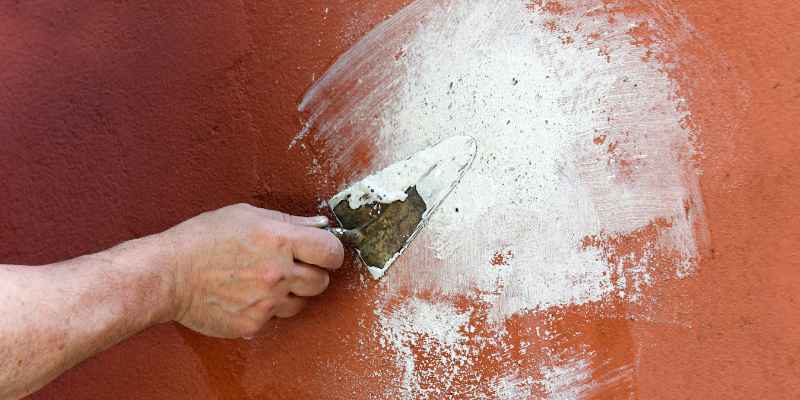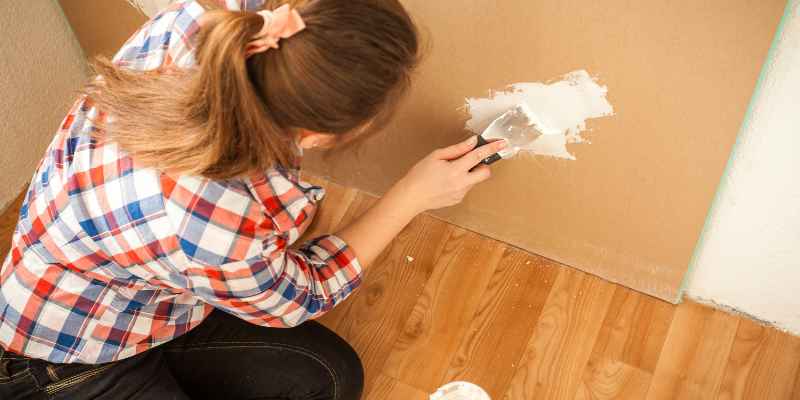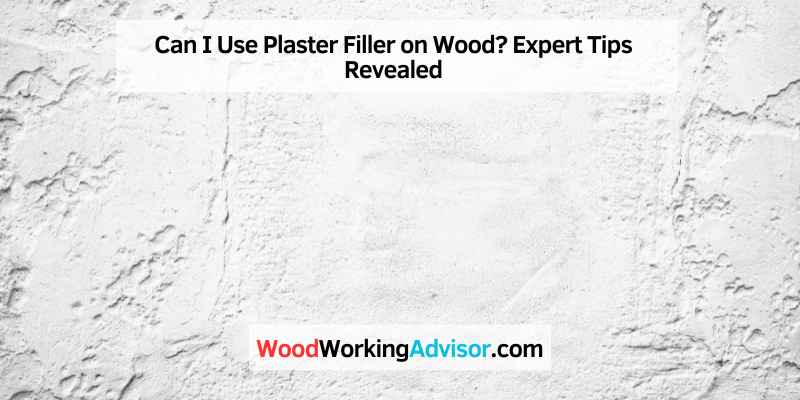Yes, you can use plaster filler on wood for minor repairs. It works well for filling small cracks or holes in wooden surfaces.
Plaster filler is easy to apply and can provide a smooth finish when sanded down. However, for larger or structural repairs, it’s best to use wood filler or epoxy for a more durable solution. Make sure the wood surface is clean and dry before applying the plaster filler to ensure proper adhesion.
Sand the area after the filler dries for a seamless repair that blends in with the rest of the wood surface.
Introduction To Plaster Filler And Wood
Plaster filler can be used on wood, but it’s not always the best option. While it can fill in small gaps and holes, it’s not as flexible as wood filler and may crack over time. Wood filler is a better choice for larger gaps and repairs.
When it comes to repairing or renovating wooden surfaces, finding the right filler is crucial. Plaster filler is a popular option that can be used on various materials, including wood. In this article, we will explore the concept of plaster filler and its compatibility with wood. Understanding the characteristics of both plaster filler and wood is important to ensure the best results for your project.
What Is Plaster Filler?
Plaster filler, also known as wall filler or wall putty, is a versatile material used for filling gaps, cracks, and holes in different surfaces. It is commonly made from a mixture of gypsum, water, and additives, resulting in a smooth and easy-to-work-with compound. Plaster filler is primarily used in the construction industry for repairing walls, but its applications extend beyond that.
Plaster filler is known for its excellent adhesive properties, making it suitable for various surfaces. Its quick-drying nature allows for efficient application, saving both time and effort. Moreover, plaster filler can be sanded and painted over, providing a seamless finish.
Characteristics Of Wood
Wood is a natural material widely used in construction and furniture-making due to its durability, versatility, and aesthetic appeal. Understanding the characteristics of wood is crucial when considering the use of plaster filler on wooden surfaces.
- Porosity: Wood has a porous nature, which means it can absorb liquids and substances. This porosity affects how well plaster filler adheres to wood.
- Expansion and Contraction: Wood expands and contracts with changes in temperature and humidity. This movement can potentially affect the durability and stability of the plaster filler.
- Grain and Texture: The grain and texture of wood can impact the application and appearance of plaster filler. It is important to consider how the filler will interact with the unique characteristics of different wood species.
- Strength and Hardness: Wood varies in terms of strength and hardness, which can affect the overall performance and longevity of the plaster filler.
Considering these characteristics, it is essential to choose the right type of plaster filler and apply it correctly to ensure a strong and long-lasting bond with the wood surface.
Comparing Plaster Filler With Wood Fillers

When it comes to repairing wood surfaces, it’s important to consider the right filler material. One common question that arises is whether plaster filler can be used on wood. To provide a better understanding of this, let’s compare plaster filler with wood fillers, focusing on composition differences and performance on wood.
Composition Differences
Plaster filler is primarily composed of gypsum, which is a soft sulfate mineral. On the other hand, wood fillers are formulated using materials such as cellulose, wood fibers, or gypsum mixed with polymers like epoxy or vinyl. The composition differences between plaster filler and wood fillers play a significant role in their performance on wood surfaces.
Performance On Wood
Plaster filler, being made of gypsum, is not an ideal choice for filling wood due to its brittle nature. It lacks the flexibility and adhesion required to withstand the natural expansion and contraction of wood. Wood fillers, on the other hand, are designed to be more compatible with wood surfaces, offering better adhesion, flexibility, and durability. They can seamlessly blend in with the wood, ensuring a more effective and long-lasting repair.
Advantages Of Using Plaster Filler On Wood
Using plaster filler on wood offers several advantages that make it a popular choice for wood repair and restoration projects. From cost-effectiveness to ease of application, plaster filler provides a range of benefits that can enhance the durability and aesthetics of wooden surfaces.
Cost-effectiveness
Plaster filler is a cost-effective solution for repairing wood as it is typically more affordable than other wood fillers. The cost-effectiveness of plaster filler makes it an attractive option for individuals and professionals seeking economical yet reliable wood repair products.
Ease Of Application
Plaster filler is known for its ease of application, making it a convenient choice for various wood repair and restoration projects. Its smooth consistency and ability to adhere well to wood surfaces simplify the filling and smoothing process, saving time and effort for users.
Challenges And Considerations
Using plaster filler on wood presents unique challenges and considerations that should be carefully evaluated. From adhesion issues to durability concerns, it is crucial to understand the potential pitfalls before proceeding with this application.
Adhesion Issues
- Plaster filler may struggle to adhere properly to wood surfaces.
- Wood’s porous nature can hinder the bonding process.
- Priming the wood surface can help improve adhesion.
Durability Concerns
- Plaster filler might not withstand wood’s natural movements.
- Moisture exposure can lead to degradation over time.
- Sealing the filler with a protective coat is advisable.
Preparation Steps For Applying Plaster Filler On Wood
Using plaster filler on wood can be a quick and effective way to repair minor damages. However, before applying the filler, it is essential to prepare the surface properly to ensure that the filler adheres well and provides a smooth finish. Here are the preparation steps you need to follow:
Surface Cleaning
The first step to prepare the wood surface is to clean it thoroughly. You can use a soft-bristled brush or a cloth to remove any dust, dirt, or debris from the surface. If there are any stains or marks, you can use a mild detergent solution to clean them. After cleaning, let the surface dry completely before moving on to the next step.
Priming The Wood
Priming the wood surface is necessary to ensure that the plaster filler adheres well and provides a smooth finish. You can use a wood primer to prime the surface. Apply a thin coat of primer using a brush or a roller and let it dry completely. If there are any gaps or cracks in the wood, use a putty knife to apply the primer into them.
Applying Plaster Filler
Once the wood surface is cleaned and primed, you can apply the plaster filler. Mix the plaster filler according to the manufacturer’s instructions. Using a putty knife, apply the filler onto the damaged area, making sure to fill the gaps completely. Smooth out the surface with the putty knife and let the filler dry completely before sanding it down to a smooth finish.
Sanding The Surface
After the plaster filler has dried completely, you can sand the surface using sandpaper. Use a fine-grit sandpaper to sand the surface gently until it is smooth and even. Make sure to remove any dust or debris from the surface after sanding.
Final Touches
Once you have sanded the surface, you can apply a final coat of primer to ensure that the surface is smooth and even. After the primer has dried completely, you can paint or stain the wood surface to match the surrounding area.
| Steps | Details |
|---|---|
| Surface Cleaning | Use a soft-bristled brush or a cloth to remove any dust, dirt, or debris from the surface. If there are any stains or marks, use a mild detergent solution to clean them. Let the surface dry completely. |
| Priming the Wood | Apply a thin coat of wood primer using a brush or a roller and let it dry completely. Use a putty knife to apply the primer into any gaps or cracks in the wood. |
| Applying Plaster Filler | Mix the plaster filler according to the manufacturer’s instructions. Using a putty knife, apply the filler onto the damaged area, making sure to fill the gaps completely. Smooth out the surface with the putty knife and let the filler dry completely before sanding it down to a smooth finish. |
| Sanding the Surface | Use a fine-grit sandpaper to sand the surface gently until it is smooth and even. Remove any dust or debris from the surface after sanding. |
| Final Touches | Apply a final coat of primer to ensure that the surface is smooth and even. After the primer has dried completely, paint or stain the wood surface to match the surrounding area. |
Application Techniques

Plaster filler is a versatile material that can be used to fix walls, ceilings, and even wood surfaces. However, using plaster filler on wood requires a different application technique than using it on walls or ceilings. In this post, we will focus on the application techniques for using plaster filler on wood.
Tools Required
Before you start applying plaster filler on wood, you will need to gather the following tools:
- Plaster filler
- Sanding paper or block
- Putty knife or scraper
- Paintbrush or roller
- Wood filler (optional)
Step-by-step Guide
Follow these steps to apply plaster filler on wood:
- Clean the surface of the wood thoroughly to remove any dirt, dust, or debris.
- If there are any large holes or cracks in the wood, fill them with wood filler and let it dry completely.
- Take a putty knife or scraper and apply a thin layer of plaster filler on the surface of the wood. Spread it evenly and make sure it covers the entire surface.
- Let the plaster filler dry completely. This usually takes around 24 hours, but it may take longer depending on the humidity and temperature.
- Once the plaster filler is dry, use sanding paper or block to smooth out any rough spots or uneven areas. Be gentle to avoid damaging the wood.
- Clean the surface of the wood again to remove any sanding dust.
- If necessary, apply another layer of plaster filler and repeat the drying and sanding process.
- Once you are satisfied with the surface, you can paint or stain the wood as desired.
Applying plaster filler on wood can be a bit tricky, but with the right tools and techniques, you can achieve a smooth and even surface. Remember to be patient and take your time to ensure a quality finish.
Expert Tips For Seamless Finish
Using plaster filler on wood can result in a seamless finish, but it requires expert techniques. Sand the wood down to roughen the surface, apply a primer, and then use a putty knife to spread the plaster filler evenly. Sand the surface again once the filler dries, and then apply paint or stain to complete the look.
Sanding And Smoothing
Before applying plaster filler on wood, sand the surface for better adhesion.
Painting Over Plaster Filler
Once the filler is dry, paint the wood for a polished look.
Real-life Examples And Case Studies
Explore real-life examples and case studies showcasing the effectiveness of using plaster filler on wood surfaces. Uncover practical insights and success stories demonstrating the compatibility and benefits of utilizing plaster filler for wood restoration projects.
Success Stories
Applying plaster filler on wood can be effective when done correctly.
Common Pitfalls To Avoid
Avoid using excessive filler on wood to prevent cracks.
Frequently Asked Questions
Can Plaster Filler Be Used On Wood Surfaces?
Yes, plaster filler can be used on wood surfaces to fill in small cracks, holes, and imperfections. However, it’s important to ensure that the wood surface is clean and dry before applying the plaster filler for better adhesion and a smooth finish.
Is Plaster Filler Suitable For Repairing Wooden Furniture?
Plaster filler is suitable for repairing minor damages on wooden furniture such as small dents, scratches, and nail holes. It provides a quick and easy solution for restoring the appearance of wooden furniture, ensuring a seamless finish when sanded and painted or stained.
What Are The Advantages Of Using Plaster Filler On Wood?
Using plaster filler on wood offers the advantage of easy application and quick drying, making it a convenient option for minor wood repairs. It also provides a smooth and durable finish when sanded, ensuring a seamless integration with the existing wood surface.
Conclusion
Using plaster filler on wood can be a viable option for minor repairs and surface leveling. However, it is important to consider the limitations and potential drawbacks. While plaster filler can provide a smooth finish, it may not be as durable or flexible as other wood fillers specifically designed for this purpose.
It is crucial to assess the nature of the project and consult with professionals or experts to make an informed decision. Overall, proper preparation and application techniques are vital for achieving satisfactory results.


